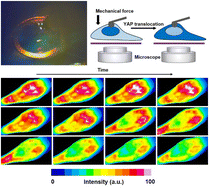Quantification of mechanical stimuli inducing nucleoplasmic translocation of YAP and its distribution mechanism using an AFM–dSTORM coupled technique†
Abstract
Cells can regulate a variety of behaviors by sensing mechanical signals, including growth, differentiation, apoptosis and so on. Yes-associated protein (YAP) is a mechanically sensitive protein that can be used as an indicator of mechanosignaling transduction. Unlike macroscopic statistical analysis, single-cell analysis is more demanding and challenging in terms of mechanistic regulation. Here, we quantified the location, amplitude and duration of single-cell mechanical stimulation by precise mechanical modulation, and simultaneously observed the mechanical force induced YAP nuclear and cytoplasmic distribution translocation using the AFM–dSTORM coupled techniques. Additionally, we investigated the regulation of YAP translocation according to the physical factors (cytoskeletal destruction and osmotic pressure) and biochemical factors (nuclear active transport protein inhibiter and starvation). Our study revealed that mechanical signals were transferred from the cytoskeleton to the nucleus through the synergistic action of microfilaments and microtubules, and then induced YAP translocation from the nucleus to the cytoplasm under the cooperation of nuclear export proteins. This conclusion deepens the understanding of the signaling pathway by which mechanical signals are transmitted from the plasma membrane to the cytoplasm and then to the nucleus to determine the cell's fate.



 Please wait while we load your content...
Please wait while we load your content...